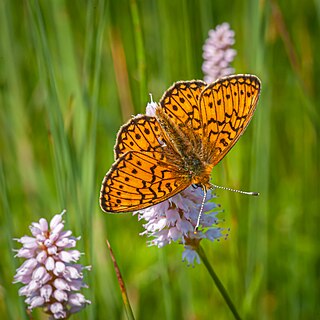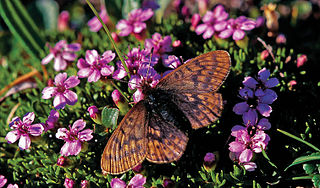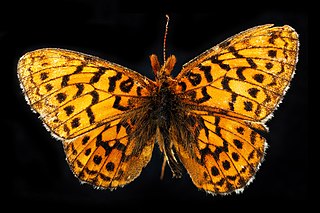
Boloria selene, known in Europe as the small pearl-bordered fritillary and in North America as the silver-bordered fritillary, is a species of butterfly of the family Nymphalidae. It is found across Europe, Asia and North America, and feeds exclusively on violets in its larval stages. This species prefers wet grassland habitats, where its larval food source, violets, are found. It overwinters in its larval stage, and eggs hatch in the late summer to early autumn. Members of this species are prey for multiple types of birds and other insects.

The Uncompahgre fritillary butterfly is a species of butterfly in the Order Lepidoptera: Family Nymphalidae that is endemic to Colorado, USA.

Boloria is a brush-footed butterfly (Nymphalidae) genus. Clossiana is usually included with it nowadays, though some authors still consider it distinct and it seems to warrant recognition as a subgenus at least.

Boloria chariclea, the Arctic fritillary or purplish fritillary, is a butterfly of the family Nymphalidae. It is found in the northern parts of the Palearctic and Nearctic realms.

Boloria eunomia, the bog fritillary or ocellate bog fritillary is a butterfly of the family Nymphalidae.

Boloria bellona, the meadow fritillary, is a North American butterfly in the brushfoot family, Nymphalidae. The common name, meadow fritillary, is also used for a European butterfly species, Melitaea parthenoides.

Boloria improba, the dingy fritillary, is a butterfly of the family Nymphalidae. In Europe it is only found in small parts of Scandinavia, more specifically the border region between Norway, Sweden and Finland. It is found in alpine or tundra habitats.

Boloria polaris, the Polaris fritillary, is a butterfly of the family Nymphalidae. It is found in northernmost Scandinavia, North America and in Greenland. It is also found in northeastern Russia and across the Palearctic to Chukotka. It is one of only six butterfly species found on Canada's Ellesmere Island.

Boloria napaea, the Napaea fritillary or mountain fritillary, is a butterfly of the family Nymphalidae.

The Balkan fritillary is a butterfly in the family Nymphalidae found in the southern Central Alps and the mid- to high-altitude Balkans. The larva feeds on Viola species.

Boloria epithore, the Pacific fritillary, is a butterfly of the family Nymphalidae. It is found in western North America from California to British Columbia and Alberta.
Boloria alberta, the Alberta fritillary, is a butterfly of the family Nymphalidae. It is found in the North American Rocky Mountains of British Columbia and Alberta and in northern Montana.
Boloria natazhati, the Beringian fritillary, cryptic fritillary or Pleistocene fritillary, is a butterfly of the family Nymphalidae. It is found from northwestern Canada as far south as northern British Columbia.

Boloria alaskensis, the mountain fritillary or Alaskan fritillary, is a species of fritillary butterfly in the family Nymphalidae. It was described by William Jacob Holland in 1900 and is found in North America and North European Russia. The MONA or Hodges number for Boloria alaskensis is 4462. The larvae feed on false bistort and alpine smartweed.

Boloria kriemhild, the relict fritillary, is a species of fritillary butterfly in the family Nymphalidae. It is found in North America.














